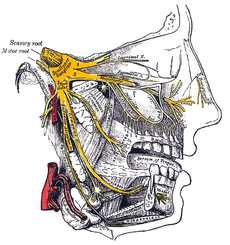- Ice-cream headache
-
"Brain freeze" redirects here. For the acute cognitive faltering due to stress, see Brain freeze (psychology). For the 1999 album, see Brainfreeze (album). For the book in the Otto Undercover series, see Otto Undercover.
Ice-cream headache Classification and external resources 
The trigeminal nerve, shown in yellow, conducts signals from dilating blood vessels in the palate to the brain, which interprets the pain as coming from the forehead.ICD-10 G44.8021 (ICD-10NA) An ice-cream headache, also known as brain freeze, cold-stimulus headache,[1] or its given scientific name sphenopalatine ganglioneuralgia (meaning "nerve pain of the sphenopalatine ganglion"), is a form of brief cranial pain or headache commonly associated with consumption (particularly quick consumption) of cold beverages or foods such as ice cream and popsicles. It is caused by having something cold touch the roof of the mouth (palate), and is believed to result from a nerve response causing rapid constriction and swelling of blood vessels[2] or a "referring" of pain from the roof of the mouth to the head.[3][4] The rate of intake for cold foods has been studied as a contributing factor.[5][6]
Contents
Cause and frequency
"Ice cream headaches" result from quickly eating or drinking very cold substances. It is commonly experienced when applying ice-cream (or similar) to the roof of the mouth (palate) or when swallowing it.[7] Typically the headache appears in about 10 seconds and lasts about 20 seconds although some people experience much longer lapses of pain, with the pain seeming to relate to the same side of the head as the cold substance was applied to the palate, or to both sides of the head in the case of swallowing.[7] The most effective way to prevent it is to consume the cold food or liquid at a slower rate. Keeping it in one's mouth long enough for the palate to become used to the temperature is also an effective preventative.
Ice cream headache is the direct result of the rapid cooling and rewarming of the capillaries in the sinuses. A similar but painless blood vessel response causes the face to appear "flushed" after being outside on a cold day. In both instances, the cold temperature causes the capillaries in the sinuses to constrict and then experience extreme rebound dilation as they warm up again.[8]
In the palate, this dilation is sensed by nearby pain receptors, which then send signals back to the brain via the trigeminal nerve, one of the major nerves of the facial area. This nerve also senses facial pain, so as the neural signals are conducted the brain interprets the pain as coming from the forehead—the same "referred pain" phenomenon seen in heart attacks. Brain-freeze pain may last from a few seconds to a few minutes. Research suggests that the same vascular mechanism and nerve implicated in "brain freeze" cause the aura (sensory disturbance) and pulsatile (throbbing pain) phases of migraines.[9]
It is possible to suffer from an ice-cream headache in both hot and cold climate conditions.
To relieve pain, some doctors suggest pressing the tongue against the roof of the mouth to warm the area[10] or tilting the head back for about 10 seconds. Another method to relieve ice cream headaches is to drink a liquid that has a higher temperature than the substance that caused the ice cream headache.
The phenomenon is common enough to have been the subject of research published in the British Medical Journal and Scientific American.[8][9]
Classification
The International Classification of Headache Disorders (ICHD) code is 13.11.2 and International Statistical Classification of Diseases and Related Health Problems ICD-10NA code is G44.8021, "Headache attributed to ingestion or inhalation of a cold stimulus".[11]
References
- ^ Jankelowitz, SK.; Zagami, AS. (Dec 2001). "Cold-stimulus headache.". Cephalalgia 21 (10): 1002. doi:10.1046/j.1468-2982.2001.00301.x. PMID 11843876.
- ^ How stuff works
- ^ Mayo clinic (causation)
- ^ Medterms.com
- ^ Ice cream evoked headaches ICE-H study
- ^ University of Guelph
- ^ a b Bird, N; MacGregor, EA; Wilkinson, MI (January 1992). "Ice cream headache—site, duration, and relationship to migraine". Headache 32 (1): 35–8. doi:10.1111/j.1526-4610.1992.hed3201035.x. PMID 1555929.
- ^ a b Scientific American Mind, 1555–2284, 2008, Vol. 19, Issue 1. "Brain Freeze." Andrews, Mark A., Lake Erie College of Osteopathic Medicine.
- ^ a b http://bmj.bmjjournals.com/cgi/content/full/314/7091/1364 Ice cream headache — Hulihan 314 (7091): 1364 – BMJ
- ^ Salemi, Vicki (June 2009). "Body Oddities Explained". AOL Health. http://www.aolhealth.com/health/mysteries-explained. Retrieved June 2009.
- ^ "ICHD-II Abbreviated pocket version" (pdf). International Headache Society. 2004. http://ihs-classification.org/_downloads/mixed/WatermarkedShortForm%20ICHD-II.pdf. Retrieved 2009-03-25.
External links
CNS disease: Headache (G43–G44, 339, 346) Primary ICHD 1ICHD 2ICHD 3ICHD 4Secondary ICHD 5ICHD 7ICHD 8ICHD 13 Trigeminal neuralgia · Occipital neuralgia · External compression headache · Cold-stimulus headache · Optic neuritis · Postherpetic neuralgia · Tolosa-Hunt syndromeOther Categories:- Headaches
Wikimedia Foundation. 2010.
